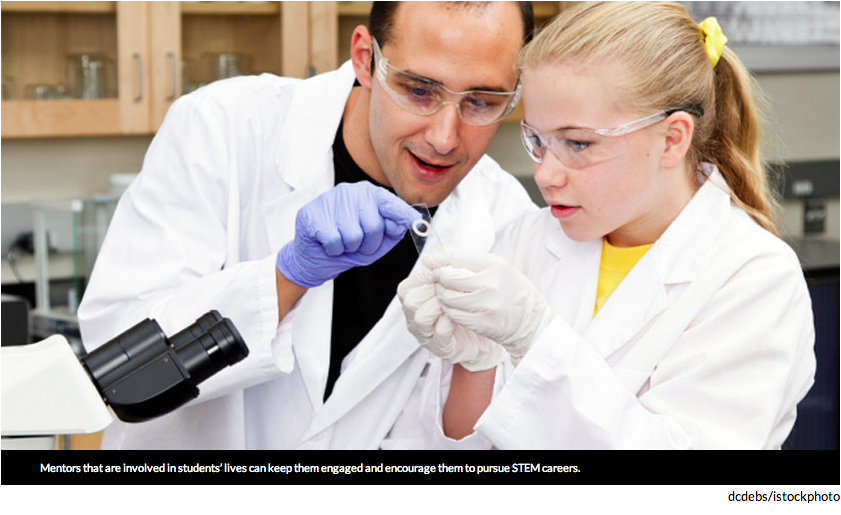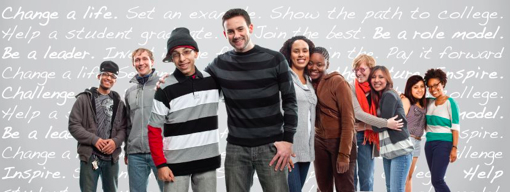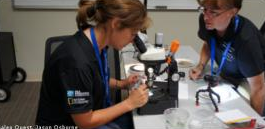Mentoring in STEM
A teacher’s guide to mentoring in STEM
How to find and be a good mentor in STEM

Mentors that are involved in students’ lives can keep them engaged and encourage them to pursue STEM careers.
Finding someone who can inspire a student to take on the demands of STEM research can be challenging, though. Students vary widely in their backgrounds, training and interests. And what they need from a mentor will evolve as a student matures. But a good mentor can make the difference between someone who chooses a career in STEM — and someone who walks away.
In the remainder of this article, the author explores mentoring and how to make it a win-win relationship for everyone involved.
Not necessarily a role model
When students seek a mentor, they need more than someone who will give them a dishwashing job in their laboratory or respond to their emails, says Mary Fernandez. She’s runs the New York City-based Mentornet. This group helps match up students who are interested in STEM fields with mentors who can give them career support and help them pursue opportunities. A listening ear and bit of empathy can make the difference between a professor dispensing advice and a mentor who understands a student’s desires and needs, she says.
Yet students often look for mentoring from the wrong source, such as a role model, observes Kate Goddard. She manages outreach and online communications for the National Girls Collaborative Project. It’s an umbrella program based in Lynwood, Wash., that brings together smaller groups to encourage young women in STEM careers and to encourage their success.
%20Olaya%20Barr.jpg)
A mentoring program called Girls Write Now provides workshops, such as this one, and one-on-one mentoring to help girls break into careers such as science journalism.
Kids often admire role models for the cool things they do or their great achievements. This can make role models very influential. That’s why Goddard started FabFems within the National Girls Collaborative projects. FabFems is a directory of women in STEM who can help teachers find female role models to inspire their students.
But being a great role model may not translate into being a good mentor, Goddard warns.
“The point of a role model is to break stereotypes,” she explains. “A role model is more of a onetime experience, where students can see and identify with someone, and be inspired to be them.” Because few students will see a role model more than a few times, they rarely develop a deep relationship with such an individual. As a young girl, I was inspired by Jane Goodall. But I have yet to meet her. She was a role model, but for a mentor, I needed someone more accessible.
Good mentoring requires time and, above all, an emotional investment. “The most important quality in a mentor is, first and foremost, to have empathy,” argues Fernandez.
Athena Andreadis is one such individual. A former molecular neurobiologist, she is now a writer and editor in Cambridge, Mass. Over the years, Andreadis has helped guide people at all stages of their research and writing careers. She agrees that mentoring is not just about pushing someone towards a particular job or educational path. A mentor must be able to see the world from a student’s point of view.
Mentoring do’s and don’ts
“Mentors should not impose their values on the mentees,” says Alberto Roca. He’s the executive director of DiverseScholar. This online program, based in Irvine, Calif., provides guidance and resources to STEM students from under-represented groups. Effective guidance, he says, requires listening closely. Mentors must learn what students want in a career, what they want for their personal lives and how their backgrounds might be differfrom their own. That information can then guide the mentor’s advice and actions.
Some students come to a mentor with clear ideas of what they need but may not articulate it clearly. Others may not even realize what areas they need to develop or strengthen. Listening carefully to subtext can help mentors understand what a mentee needs to succeed.
Often, a student will tell a mentor what they need “without even realizing that they are doing it,” observes Rachelle Oldmixon. A psychologist in Los Angeles, Calif., she’s a contributor on Al Jazeera’s weekly science video series, TechKnow. She describes her recent experience tutoring high school students who were studying for a college entrance exam, the SAT. One student had been struggling for weeks to get his ideas onto paper. At his last session after a preparation test, he asked his mentor: “Why did I get a good score in the ‘supporting sentences’ section? I didn’t think I would.’” His confusion gave Oldmixon the clue to his struggles: The student had never been taught how to write an essay.
Careful listening can help mentoring relationships grow. Oldmixon says her own relationships with mentors as she was growing up were “a lot like friendship. My best mentors treated me as an equal. All of my ideas were valid.” Because of this, Oldmixon notes that the mentoring relationship may end up being a much closer one than what a student develops with a teacher.
But mentors can be far more than just a friend with the skills and experiences that a student lacks. Mentors often provide guidance to help students succeed in their prospective careers.
That’s what Mark Chu-Carroll found. His college advisor kept Chu-Carroll’s career goals in mind as he advised him on what courses to take and what research to try. This advisor — and mentor — also introduced the young man to people who might help him get a job. He also told Chu-Carroll which computer languages might be most useful to learn. Today Chu-Carroll is a software engineer for Twitter in New York City.
Some students may benefit from having more than one mentor, each of whom tackles a different aspect of the student’s life. Melissa Wilson Sayres, a geneticist at the University of California, Berkeley, says she ended up with two professors in graduate school who mentored her as she prepared for her first research job. She describes the first as her motivator, someone who “believed” in her. The other “validating” mentor “helped me to believe in myself,” she explains.
Mentoring at every age
Many students don’t realize they need a mentor until college or graduate school, Fernandez says. But this doesn’t mean that a younger student doesn’t need or won’t benefit from having a mentor.

The word “mentor” comes the character of Mentor from Homer’s Odyssey. Mentor (right) was designated to tutor Odysseus’ son Telemachus (left).
Indeed, Jean Rhodes emphasizes that mentoring is vital at all ages. A psychologist at the University of Massachusetts in Boston, she directs itsCenter for Evidence-Based Mentoring. Its scientists conduct research on mentoring to better understand which relationships are most effective. The center has shown in its Elements of Effective Practice for Mentoring that the best mentoring relationships provide close, supportive bonds. These let students develop their own vision of what their lives should be like. Good mentors also encourage students to reach their potential.
What students need from a mentor changes as they mature. Younger kids, for instance, may be focused on forming personal relationships with an adult who offers guidance. These early mentors may be relatives or family friends. That was true for Jedidah Isler. Mom was her first mentor. The woman set high standards and instilled a good work ethic in her daughter, who is now an astrophysicist at Syracuse University and Harvard University.
Their close relationship never focused on physics, Isler says. Still, it taught her to focus on doing her best. Mom, she recalls, “first instilled in me the notion that I could do anything I put my mind to.”
As kids proceed through middle and high school, they will “begin to gravitate toward mentors that can guide them toward the career that they want,” notes Rhodes. A student interested in dinosaurs might seek out a paleontologist. A tween into conservation might be attracted to an aquatic biologist.
Middle school is an especially important time for STEM role models and mentors. This “is when kids really get disengaged with STEM,” says Goddard. “That’s also when they make decisions about who they want to be.”
Without mentors and role models, students may feel there are few people with whom they can relate on science or technical subjects. The net result, Fernandez says, is that many tweens and early teens — especially young women and minorities — leak out of the STEM pipeline.
Katherine Sebeck, a materials scientist at the University of Michigan in Ann Arbor, says that her eighth-grade physical-science teacher had a huge impact on sustaining her love of science. That teacher “was the first confident, exuberant woman in STEM I met,” Sebeck says — at least the first one outside of her family. Best of all, she recalls, “She really taught me to be joyful about science and to have fun with it.”
In the remainder of the article, the author explores where to find mentors in STEM









